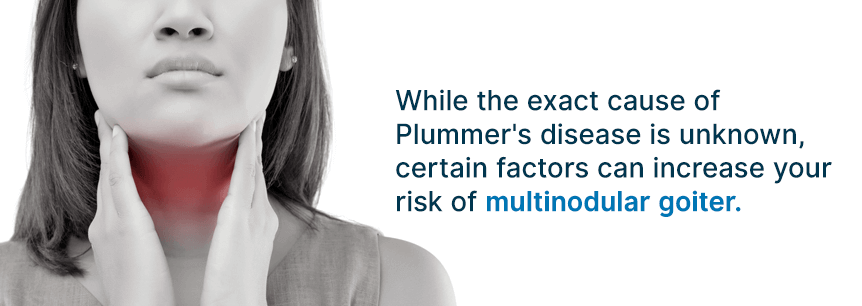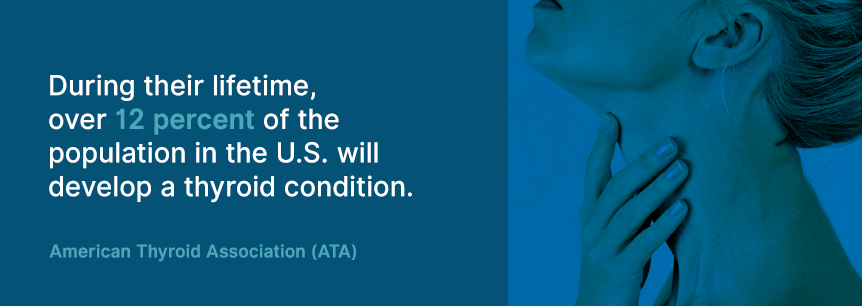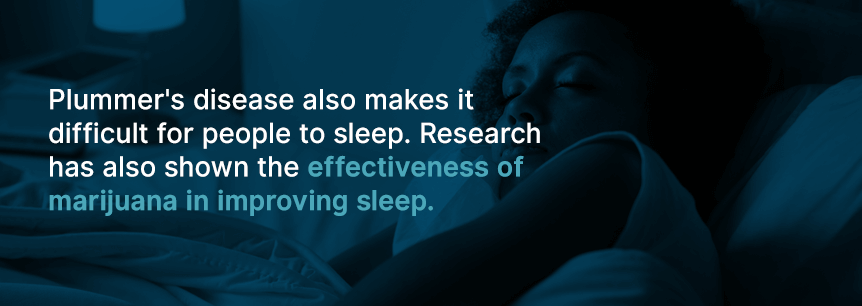
Are you struggling with irritability, trouble sleeping, difficulty swallowing or nervousness? Perhaps, you’re feeling anxious or depressed. If so, you may be suffering from a condition called Plummer’s disease. The good news — cannabis can help treat Plummer’s disease.
Plummer’s disease also referred to as toxic multinodular goiter, is a thyroid disorder characterized by a firm thyroid, marked enlargement of the thyroid gland (goiter) and overproduction of thyroid hormone (hyperthyroidism).
This condition usually occurs in older individuals. Plummer’s disease’s symptoms are similar to those of hyperthyroidism with thyroid gland inflammation.
To diagnose Plummer’s disease, physicians rely on a physical examination, blood tests of several thyroid hormone levels and ultrasound imaging tests. In some cases, particularly if your nodule is larger than one centimeter, your doctor may recommend a biopsy to test for the presence of cancerous cells. Your physician performs the biopsy through a procedure using guided ultrasound and fine needle aspiration (FNA).
There’s no known cause of thyroid cancer. Researchers aren’t sure about the exact causal relationship between thyroid cancer and multinodular goiters, but multinodular goiters do increase your risk of thyroid cancer, so individuals should get a cancer screening if they have this type of goiter.
Multinodular goiters don’t always cause symptoms. Your doctor will often find you have this condition while they conduct an imaging study or a physical exam for another unrelated cause. However, when you develop symptoms associated with Plummer’s disease, you develop a goiter years before you begin experiencing hyperthyroidism symptoms. You likely are likely over 50 years old before the characteristic accelerated heart rate appears along with other cardiac conditions.
Plummer’s disease, unlike Graves’ disease, doesn’t usually cause bulging of the eyes. Cardiac symptoms could lead to congestive heart failure.
In some cases, a multinodular goiter will feel like one nodule, but consist of a few smaller ones. An individual might feel the nodules over their thyroid directly. Your thyroid is in your neck just below your Adam’s apple.
If a goiter grows big or presses against neighboring structures, you might notice the following symptoms:
An individual with a toxic multinodular goiter could also have hyperthyroidism symptoms, including:
While the exact cause of Plummer’s disease is unknown, certain factors can increase your risk of multinodular goiter.

Iodine deficiency is one factor that can increase your risk, although it’s rare in the U.S. You have small amounts of the mineral iodine in your diet.
Your thyroid uses iodine for producing its hormones. When you don’t have enough of the mineral, your thyroid can’t perform its regular functions. Because of this, food manufacturers usually add iodine to salt, referred to as iodized salt, to help decrease the prevalence of thyroid dysfunction.
Some individuals have higher risk factors for multinodular goiter development. Some risk factors include:
If your thyroid gland isn’t producing enough thyroid hormone, your brain’s pituitary gland will start releasing more of the thyroid-stimulating hormone (TSH). The extra TSH could enlarge the thyroid and create Plummer’s disease.
Moreover, an overactive thyroid making too much of the thyroid hormone could also enlarge the thyroid and create Plummer’s disease.
In most cases, an individual might have Plummer’s disease with no known cause.
Some multinodular goiters are toxic, meaning they produce too much thyroid hormone. When this happens, it leads to hyperthyroidism.
Extremely large goiters can also lead to compression symptoms like trouble swallowing or breathing. If your multinodular goiter is big enough to result in these symptoms, the doctor will probably recommend surgery.
Usually, Plummer’s disease by itself isn’t a life-threatening condition.
Individuals are often older and have:
The hypermetabolism might worsen other medical issues, thereby getting the disease to the point it requires immediate therapy. The RAIU, or radioactive iodine uptake test, is frequently only moderately elevated or it could be in the higher normal range.
Statistics provided by Cancer Therapy Advisor show:
Other statistics provided by the American Thyroid Association (ATA) reveal:

Lastly, the National Cancer Institute (NCI), reports:
Noncancerous goiters not causing symptoms don’t always require treatment. In some cases, the doctor may suggest monitoring the goiter to see if it gets any bigger. If it does grow big or begins to cause symptoms, there are various treatment options.
One treatment option is radioactive iodine. Physicians use this treatment for shrinking goiters in hyperthyroidism cases. It destroys part of the thyroid, bringing levels of thyroid hormone production back to its regular state. Some might develop hypothyroidism after this treatment.
Propylthiouracil and methimazole are medicine options used for treating hyperthyroidism by reducing how much thyroid hormone is in your body.
Side effects of these medications may include:
If the goiter has become extremely big or causes trouble with swallowing or breathing, a surgeon can remove part or all the thyroid. The amount of thyroid they remove will depend on how large the goiter is, the number of nodules there are, if you have any toxic nodules or if there are signs of cancer. The doctor will likely recommend surgery if any of the nodules are cancerous. If the surgeon removes all of your thyroid gland, you’ll require lifelong thyroid hormone replacement treatment.
In cosmetic reasons for eliminating the gland or the absence of obstruction, the doctor may treat goiter with radioactive iodine therapy or medications that block thyroid activity. However, the characteristic of multiple thyroid nodules of the disease might increase suspicion of cancer and may necessitate surgical excision of the gland.
Surgical therapy can offer a swift recovery from the condition, and avoidance of any adverse effect from medication or radioactive iodine therapy. However, the downside to surgery includes the presence of a scar and risk of complications. Using an experienced thyroid gland surgeon can minimize complication risks.
Researchers conducted clinical trials for Plummer’s disease, including those below, to learn more about the condition and its treatment options. These were:

When you’re struggling with hyperthyroidism, cannabis could help alleviate many of the symptoms of the thyroid disorder, including:
A common cause of hyperthyroidism is Grave’s disease and is characterized by inflammation throughout your body.
Studies reveal cannabinoids help maintain balanced energies in the body, especially the endocrine system. Cannabis may be the answer for hyperthyroidism and other thyroid disorders associated with Plummer’s disease.
Researchers are beginning to notice a correlation between your body’s endocannabinoid system (ECS) and your thyroid/brain communication network. The ECS is present in both your central nervous system and thyroid gland. It could play a substantial role in helping with proper communication between your brain and thyroid, indicating your ECS and its cannabinoid receptor network can promote effective thyroid hormone release directly — essential for healthy organ functioning and overall homeostatic health.
CBD oil provides people with some outstanding health benefits and doesn’t create that “high” that THC does. CBD has already treated autoimmune and inflammatory disorders successfully.
People can use medical cannabis for Plummer’s disease and treat just about every form of thyroid malfunction such as:
Anecdotal reports about efficient and successful CBD treatment confirm these claims.
Marijuana for Plummer’s disease can help treat the below symptoms.
You’ve probably already heard of how powerful marijuana is for treating anxiety. Studies about medical weed and anxiety show the herb has components similar to those of manufactured pharmaceuticals to treat symptoms of anxiety.
Plummer’s disease also makes it difficult for people to sleep. Research has also shown the effectiveness of marijuana in improving sleep. Individuals have provided anecdotal evidence that shows excellent results when they used medical pot to improve their sleep.

When you’re not getting enough quality sleep, you’re likely going to experience fatigue. Some patients report cannabis improves their symptoms of fatigue. Most say it was the Sativa-dominant strains that help with their tiredness because they are the most energizing. Disturbed or unrefreshing sleep, joint and muscle pain, depression and emotional imbalance are all symptoms that medical marijuana for Plummer’s disease can provide relief for.
Medical cannabis can also help treat and alleviate certain side effects of medications for Plummer’s disease such as:
If you’re not sure where to start when deciding on the right strain to use for your symptoms, here are some medical marijuana strains to help you with Plummer’s disease:
If you have trouble sleeping, try Green Crack, Jack Herer or Blue Dream.
For anxiety or depression, try Granddaddy Purple, Pineapple Express or Cinex.
If you’re suffering from weight loss, try Cherry Pie, Super Silver Haze or Chocolope.
To combat fatigue, try Jack Herer, Juicy Fruit or Durban Poison.
To ease nausea and vomiting, try Death Star, Sunset Sherbet or Cheese.

In addition to choosing the right marijuana for Plummer’s disease, you also need to determine the best method of using it. Each administration method affects you differently, and various factors will help you decide which one is best for you.
Inhaling marijuana by smoking offers the fastest effect, which is helpful when you’re feeling nauseous suddenly and require quick relief. However, smoking can have respiratory side effects. Therefore, you can try other better methods including:
1. Beverages: You can toss a bud of cannabis into a pot of boiling water and brew yourself a nice cup of weed tea. There is also the option of weed beer and weed soda.
2. Capsules: Like a lot of other medications, you can also take medical marijuana by capsule or pill form. Capsules are more concentrated and potent, so make sure you know the precise dose before you take them.
3. Dabs: Dab is also called BHO (Butane Hash Oil) and wax. They’re strong hash oil extracts you smoke.
4. Sprays: These are tinctures inside spray bottles. They’re quick, convenient, discreet and effective. One little spritz in your mouth and that’s it.
5. Tinctures: Marijuana tinctures are extracts derived from the marijuana plant and are highly potent and easy to manage. You place a few drops under your tongue.
6. Vaporizers: These you heat the herb to activate the cannabinoids without smoke. Vaporizers are better for your lungs as well.
7. Edibles: Edibles are another favorite method by many individuals. They’re a delicious and easy way to consume your medical weed. They take longer to feel the effects, but the benefits can last longer than other methods.
If you’re considering trying medical cannabis for Plummer’s disease, you’ll want to first consult with a cannabis doctor. MarijuanaDoctors.com can help you obtain information on state laws, appointments, products, and other research as our website has an abundance of resources for you to use.
The process of becoming a medical cannabis patient for Plummer’s disease is easier than ever with Marijuana Doctors. Use our portal to book your appointment now.
Find A Doctor Find A Dispensary